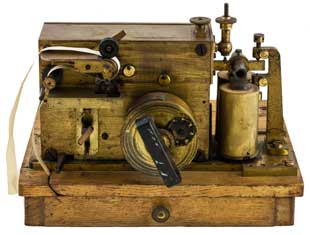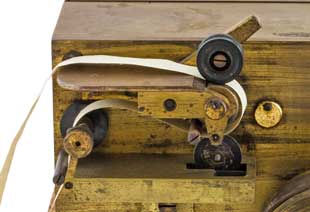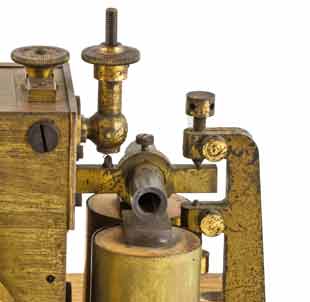Morse Code / Telegraph Inker Machine
Although most Morse code messages were copied down by an operator, sometimes a direct record of the message was needed and for this a Morse Inker was used as part of the telegraph system.
Morse Telegraph History Includes:
Morse telegraph history
Morse keys development
Vibroplex & mechanical bug keys
Telegraph sounder
Morse inker
Samuel Morse
Fascinating facts
Morse code SOS message
Morse keys:
Clipsal key
Camelback
Walters Electrical Patt 1056A Post Office key
Steel lever Morse telegraph key
RAF Bathtub Morse key
Samson ETM-5C electronic keyer
Although Morse telegraph traffic was read by operators and written down by them, on some occasions a direct indication of the characters sent over the wire was needed.
Although operators were very practised at sending and receiving, when a message had been sent, there was no way or retrieving it if letters were missed. Also if a permanent record was needed, then the hand writing of the operator may not have been sufficient.
Another instance when a Morse telegraph inker machine may have been required was if a station was to be left unattended for a short while. Messages sent would appear on the inker machine, although for longer periods of inactivity, lots of paper would be wasted.
When this was required, typically a Morse telegraph inker was used. These Morse code machines were used on a number of occasions although these machines are now relatively rare.
Morse inker beginnings
Although Samuel Morse invented a Morse embosser which was used for the 1844 inaugural transmission, this Morse code machine was not particularly effective because it was difficult to read the embossed markings.
The next Morse telegraph machine as a chemical recorder introduced in 1845 by Bain.
However the most successful Morse code machine was the Morse Inker which was invented in 1854 by Thomas John of Vienna.
The Morse inker used an inked wheel which was brought into contact with the paper for key down periods. The paper was moved along powered by a clockwork motor, so it would not keep operational indefinitely. However the clockwork mechanisms were developed sufficiently well so that they would be able to operate satisfactorily for some while, and they could easily be re-wound as needed.
Morse inker photos

In this machine, the inked wheel moves up and down to provide the intermittent inking of the dots and dashes on the paper. The clockwork motor is regulated to provide a constant paper speed and in this way make the makings decipherable.
This Morse inker is a British machine from the early 1900s.

The paper feed system stored paper similar to that used for punched tape used for teleprinters and the like. It was a long roll and about an inch across. This was fed through the paper handling system shown, and the inked wheel dropped onto it when the inker was activated during key down periods. It lifted away from the paper for key-up periods.
The paper was fed through at a steady rate by the clockwork mechanism so that the length of the dots and dashes could be seen.

The electromagnet system was similar to that used on sounders. It pulled levels to actuate the inked wheel so that it came into contact with the paper during key down periods.
 Written by Ian Poole .
Written by Ian Poole .
Experienced electronics engineer and author.
More History:
Radio history timeline
History of the radio
Ham radio history
Coherer
Crystal radio
Magnetic detector
Spark transmitter
Morse telegraph
Valve / tube history
PN junction diode invention
Transistor
Integrated circuit
Quartz crystals
Classic radios
Mobile telecoms history
Vintage mobile phones
Return to History menu . . .




